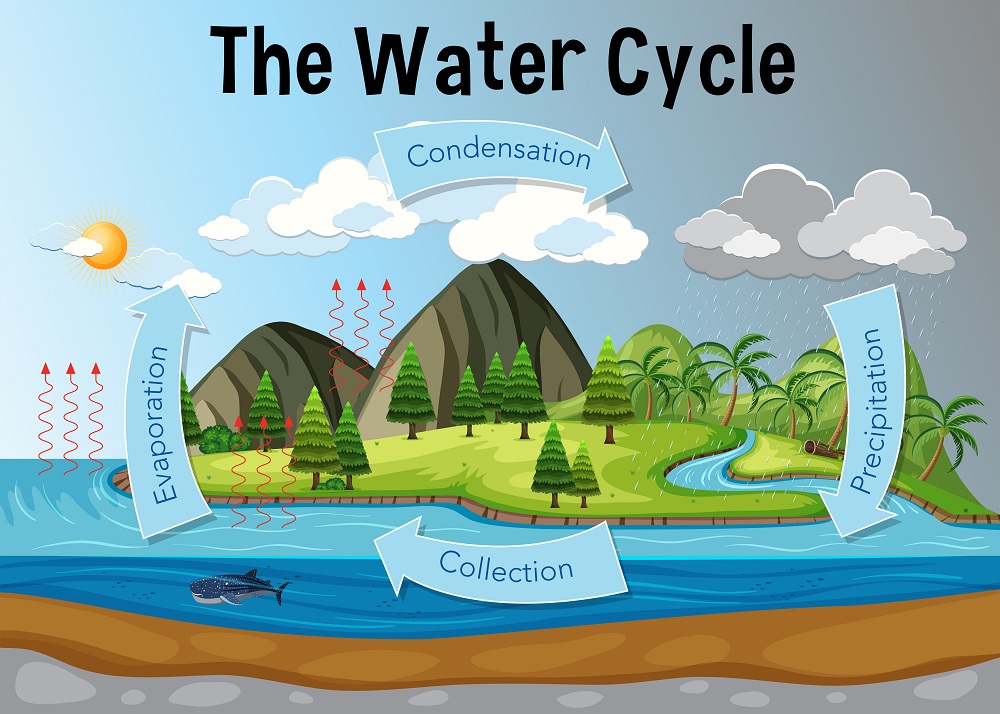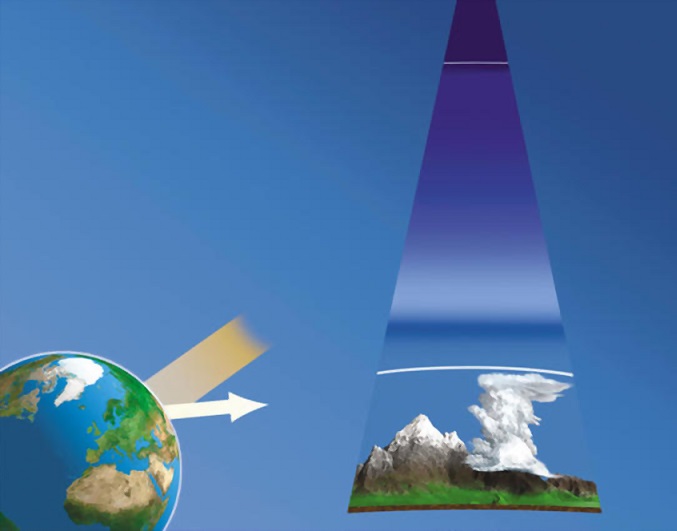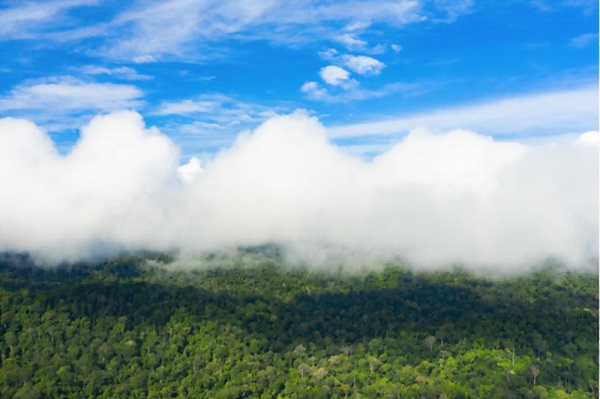Definition
The water cycle or hydrologic cycle describes the complex systems that allow water to move across the Earth and atmosphere. The most basic step of the water cycle is the change of state of water as a liquid, gas or solid in the atmosphere. However, the water cycle also envelops various methods of water transportation and water types such as plant uptake, transpiration, groundwater, precipitation, and percolation.

Water Cycle Steps
Water cycle steps are becoming less predictable as global warming changes water levels and distribution across the globe. This subcategory of the biogeochemical cycle should also not be discussed as a sequenced number of events as different modes of water uptake, transportation and return occur simultaneously and at different rates according to variances in global or local ecosystems. A mountainous region will experience significantly more sublimation and runoff, for example, when compared to flat, open plains. In fact, when discussing water cycle steps it is easier to look at the movement of water separately: going up and coming down.
Water Goes Up
Water cycle steps in the atmosphere are easy to see wherever a cloud is visible. A cloud is the result of water condensation that is added to the atmosphere by way of water evaporation, water sublimation, and water transpiration. Water can move through the troposphere by way of another water cycle step – water transportation. Water can return to the Earth’s crust through water precipitation and deposition.

The atmospheric water cycle takes place in the lowest layer of our atmosphere or the troposphere. The troposphere extends from the Earth’s surface and reaches heights of 4 miles at the two poles and up to 12 miles at the equator. The layer above – the stratosphere – contains very little water vapor.
Water vapor in the atmosphere is extremely important as these droplets are able to absorb solar energy as well as the heat that radiates from the Earth (thermal radiation). It is water vapor that regulates local climates and air temperatures. Variances in temperature, in turn, cause currents of air known as convection currents that help to create the wind patterns so often typical to a certain region, such as monsoon storms or desert zephyrs.
As already mentioned, the basic water cycle describes the exchange and movement of water between the earth and its troposphere. The powerful heat of the sun evaporates large quantities of water from the Earth’s surface, and this atmospheric moisture is transported to other regions by the wind.
As the air within the troposphere warms and rises, water molecules respond to the heat energy and move further away, expanding the space in which they exist. This leads to a loss of heat energy and cooling, where water vapor condenses and forms clouds. As this vapor further condenses, it forms water droplets which then become heavier and fall to the earth in liquid or solid (rain, hail, sleet, and snow) form, depending on the ambient temperature.
The troposphere gains water molecules through four mechanisms. These are evaporation, sublimation, transpiration, and transportation.
Evaporation as a part of the water cycle describes the change of water from liquid to gas. Our oceans, seas, lakes, and rivers provide approximately 90 percent of the troposphere’s water vapor via evaporation. Water vapor is a gas. When the sun warms the surface of the water, whether this is the ocean or a puddle on the ground, water molecules are given the energy to move at faster and faster rates, splitting off and entering the air as the equivalent of steam. The warmer the heat source, the more the water will evaporate. A saucepan full of water will create large amounts of steam or water vapor.
Sublimation is the forming of water vapor directly from solid water or ice. Sublimation is more likely to occur at high altitudes such as snowy mountain tops where the heat of the sun is hardly obstructed. One cubic centimeter or gram of ice will need 80 calories worth of energy to melt, 100 calories to boil, and a further 540 calories to vaporize. Sublimation requires this total of 720 calories of heat energy but skips the liquid phase, where ice immediately turns to water vapor. However, in high humidity, it is more likely that there will also be an intermediate liquid form of water. In the United States, it has been calculated that solar energy provides an average area of land with approximately 500 calories per square foot per day. This increases in mountainous regions and current renewable energy research is considering mountain-top solar farms for higher energy production. This shows that sublimation provides a large amount of the atmosphere’s water vapor, although in significantly lower quantities than evaporation – around 1%.
Transpiration is the conversion of water by plants into water vapor. In ideal conditions, plants only use around 5% of the water they take up through their root systems. One only has to see pictures of the mist above a rainforest to understand this contribution to water vapor levels in the troposphere. Under the sun’s rays, water escapes through leaf pores as a gas. The combination of evaporation and transpiration is called evapotranspiration. While transpiration is probably responsible for 10% of the troposphere’s water content, combined evapotranspiration provides about 99%.

Transportation does not provide water vapor to the troposphere but describes the movement of water via the wind or the jet streams – strong wind currents at the top of the troposphere or at the tropopause, a level of air between the troposphere and stratosphere. We can see the effects of transportation by watching clouds move across the sky. In addition, winds remove water vapor from the air above sources of water. This lowers the saturation levels (or humidity) of the air and allows even more water vapor to enter the atmosphere.
Water Goes Down
Water cycle steps on the Earth’s crust are highly dependent on the type of ecosystem. These steps are water condensation, precipitation, and deposition.
Water does not fall to earth in the form of water vapor. As water vapor rises, it loses heat energy through continuous motion. In addition, gaseous forms of water experience less pressure as they rise. Where there is less pressure, the air is unable to hold as much water as when pressures are high. Furthermore, other substances in the air such as pollen, pollutants, and dust provide a surface on which water vapor can settle and condense. Condensation is the opposite of evaporation and we have all seen the effect of condensation on windows and bathroom mirrors. As warm water vapor hits a cooler surface, energy levels dramatically drop. The water molecules no longer move at rapid rates and settle as water droplets. This also occurs in the atmosphere in the presence of condensation nuclei – small particles onto which water vapor can settle.
Clouds are the result of condensed water vapor. Eventually, they become saturated and are no longer able to hold liquid water droplets. This leads to precipitation.
Rain is the most common example of water cycle precipitation. Other forms are hailstones, sleet, and snow.
Deposition is the opposite of sublimation. In cases of deposition, water vapor is instantly converted from gas state to solid state (ice) without the intermediate liquid phase. In contrast to sublimation, the process of deposition releases energy. Deposition can be seen in snowfall and in the formation of frost.
Intermediary
Intermediary water cycle steps provide a bridge between water landing on the Earth’s surface and water vapor rising into the troposphere.
Infiltration is the absorption of water by the soil and rock of the upper level of the Earth’s crust and is very much dependent on environmental factors such as soil or rock depth, vegetation levels, saturation levels, and porosity. Percolation describes the flow of this infiltrated water through the soil or rock under the force of gravity. Eventually, percolated water will reach an impenetrable layer of non-porous rock. The water settles here in aquifers. You can make your own scale model of an aquifer by digging a deep pit in the sand when next on the beach. The pools or reservoirs of water that form above non-porous rock are called aquifers, but the water they contain is known as groundwater. Groundwater is another named phase of the water cycle and does not describe a step but the result of precipitation, infiltration and percolation.
Plant uptake is another way in which the water provided to the earth’s crust via precipitation and infiltration can be absorbed. Plant root systems take up water, using it as a nutrient source and discharging water vapor through leaf pores in the earlier described transpiration phase.
Where the ground is saturated and unable to deal with high levels of precipitation, another part of the water cycle takes place. This is water runoff. Water runoff is becoming a global problem due to the effects of global warming. Gravity is an extremely important factor when water droplets fall from the clouds. As everyone should know, water moves downhill. Where precipitation is high and the land it falls on is either limited in porosity or already saturated with water, water begins to flow downwards. Runoff may also be the result of snow melts.
Runoff is the combination of surface runoff, interflow, and baseflow. Surface runoff comes in the forms of saturation excess overland flow where the ground is already wet and unable to absorb more water, and overland flow or the runoff from our roofs, sidewalks and roads. As we increase non-porous infrastructures, we simultaneously reduce the globe’s ability to absorb precipitation. Storm runoff also occurs during heavy rainfall.
Interflow but involves water that has already percolated into lower soil levels. With the next heavy rain, this already saturated soil or rock is not given the time to reach the aquifer and water rises upwards to the soil subsurface and pushes upwards to produce increased surface runoff.
Baseflow or fair-weather flow describes how moving bodies of water such as streams and rivers take on infiltrated water over a longer period of time, between precipitation (hence ‘fair weather flow’). This is a delayed response but also contributes to runoff as an already present body of water that can increase dramatically in size in the days that follow precipitation events.
Water Cycle Facts
- our oceans hold 96.5% of the earth’s water. This means that a single water molecule might not be given the opportunity to move from ocean to troposphere for tens of thousands of years.
- Approximately 45 inches of water evaporate from the surface of the World Ocean every year; with a total surface area of 139.4 million square miles, that’s a lot of water vapor.
- The troposphere contains 99% of our atmosphere’s water vapor.
- The temperature in the troposphere can be as low as -115°F.
- There is over a thousand times more water under the ground than in all of our Earth’s rivers, streams and lakes.
- Although water covers 75% of the Earth’s surface, water represents just 0.05 percent of its total mass.
- The average modern-day European uses 50 gallons of freshwater per day. The average medieval European used less than 5 gallons per day.
- To grow a single cultivated tomato, you need 2.5 gallons of water. To grow a single grain of rice – just one grain – you need 0.05 gallons of water. If one portion of rice is about 3500 grains, that’s 175 gallons per meal. However, a loaf of factory-produced bread has used around 570 gallons of the Earth’s water before it arrives on the supermarket shelf.
- A small, thirty-minute thunderstorm can produce around 2000 tons of rain.
- 21 out of 37 of the world’s major aquifers are receding due to increasing population, and industrial and agricultural demands. This means we need to find alternative freshwater sources. In Israel, 86% of wastewater is recycled. The next-best global performer is Spain – this runner-up manages to recycle just 19% of its wastewater.
Quiz
1. How does the troposphere gain water molecules?
A. Evaporation, percolation, and sublimation
B. Evaporation, precipitation, transportation, and sublimation
C. Evaporation, sublimation, transpiration, and transportation
D. Evaporation, sublimation, and transpiration
2. Where do you find jet streams?
A. In aquafers
B. In the troposphere
C. In the oceans
D. In the stratosphere
3. Which of the following provides the most water vapor?
A. Precipitation
B. Sublimation
C. Evapotranspiration
D. Condensation
4. Which of the following is a delayed response to heavy precipitation?
A. Infiltration
B. Interflow
C. Baseflow
D. Runoff
5. What will you find under an aquifer?
A. Non-porous rock
B. Saltwater
C. Freshwater
D. Sand
